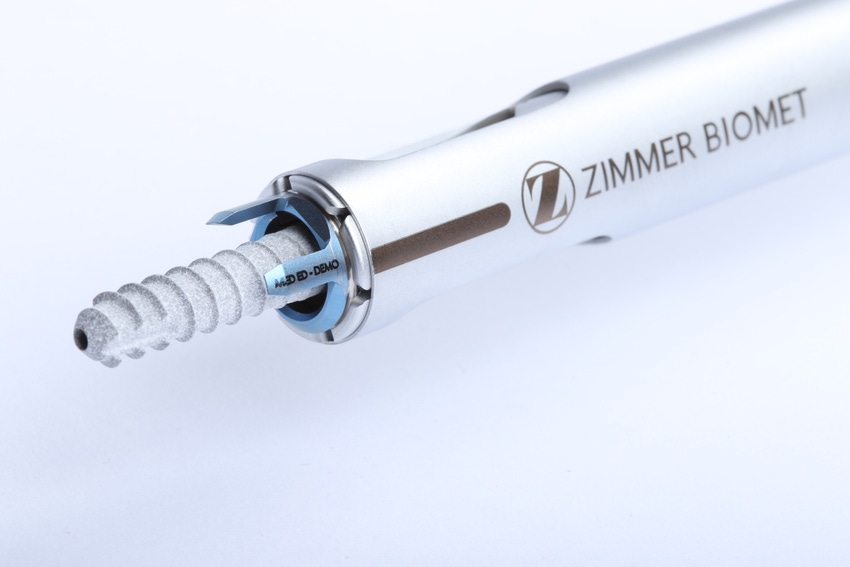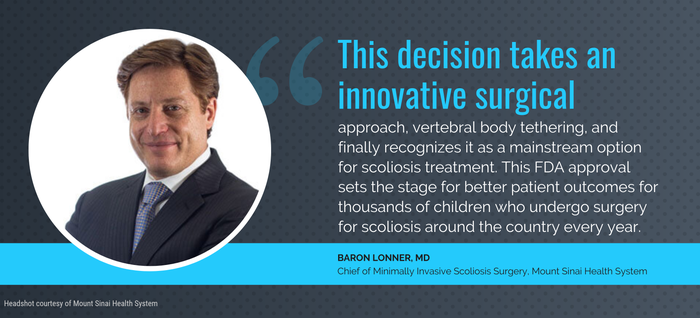A Scoliosis Win: FDA Approves Vertebral Body Tethering
Zimmer Biomet's first-of-its-kind spinal tether device sets the stage for helping thousands of kids with scoliosis, according to a top scoliosis specialist at The Mount Sinai Health System.
August 16, 2019

A first-of-its-kind FDA approval represents a major win for Zimmer Biomet and, most importantly, the field of scoliosis treatment.
Called The Tether – Vertebral Body Tethering System, the device is intended to treat growing children and adolescents whose spinal curves are approaching or have reached the range where surgical treatment is an option. It is intended to correct the most common form of scoliosis (idiopathic scoliosis) that has not responded to conservative treatment options, such as external bracing.
“This decision takes an innovative surgical approach, vertebral body tethering, and finally recognizes it as a mainstream option for scoliosis treatment,” said Baron Lonner, MD, chief of minimally invasive scoliosis surgery at The Mount Sinai Health System. “This FDA approval sets the stage for better patient outcomes for thousands of children who undergo surgery for scoliosis around the country every year.”
Lonner, a world-leading scoliosis specialist, is among the few surgeons performing vertebral body tethering (VBT) in the United States prior to this approval. He has performed VBT more than 220 times. Prior to this approval, these specialists were repurposing an implant that was initially approved for use in adult lumbar procedures, slightly modifying the implant for use in the pediatric population. The benefits of VBT led to growing demand from patients and their families, contributing to FDA’s decision to approve the new implants, according to Mount Sinai.
“For children and adolescent patients with idiopathic scoliosis that does not respond favorably to bracing, treatment options have been limited to fusion surgeries,” said Capt. Raquel Peat, PhD, director of the Office of Orthopedic Devices in FDA’s Center for Devices and Radiological Health. “Today’s approval provides access to a new treatment option that could improve the quality of life for patients with idiopathic scoliosis.”
Unlike spinal fusion, the standard scoliosis surgery, VBT employs a rope-like device that is pulled tight alongside the spine, helping guide the patient’s growth and facilitating straighter alignment of the spine. With VBT, patients are able to maintain a higher level of flexibility and functionality after surgery. Also, unlike fusion metallic rods, The Tether is positioned using an endoscopic minimally invasive approach through a few small openings between the ribs, Zimmer Biomet said.
“Patients have become increasingly interested in non-fusion surgical options for treating scoliosis," Lonner said. "With VBT, patients can maintain flexibility and function in a way one can’t with spinal fusion, and the medical community is optimistic that VBT will contribute to less degenerative disc problems over the long-term as well.”
FDA approval of the new implants is expected to result in more surgeons beginning to perform VBT. The ramp-up may be slow, however, due to the extremely specialized approach required for the procedure, Mount Sinai said. Unlike other surgical approaches to treating scoliosis, VBT is dependent on a minimally invasive anterior approach, which can take years to master.
Idiopathic scoliosis is a sideways curvature of the spine and its cause is unknown. It is the most common spinal deformity in children and is most often diagnosed between ages 10 to 18, although it may occur at a younger age, FDA noted. The standard treatments for idiopathic scoliosis among children and adolescents who are still growing are conservative, non-surgical treatments such as external bracing to help correct the spinal curvature. But nearly 6,800 U.S. patients each year will develop progressive curvatures that do not respond to bracing. For these patients, spinal fusion surgery may be used to permanently stabilize and correct spinal curvatures. While spinal fusion is often successful, the surgery permanently restricts the motion of the spine and may have long-term complications such as pain, arthritis, and future spinal deformities, which could require additional surgical treatment, FDA said.

How does this work for scoliosis?
The Tether – Vertebral Body Tethering System provides an alternative for patients with idiopathic scoliosis that doesn’t respond to bracing. As a patient grows, The Tether – Vertebral Body Tethering System is designed to continue to correct the curvature while maintaining a fuller range of motion when compared to spinal fusion procedures.
The system includes anchors and vertebral body screws that are placed into the same side of each vertebra in the curved section of the spine through an incision on the side of the chest. A flexible cord, called a tether, is connected to the screws. Tension is applied to the tether during surgery to compress one side of the spine and to partially correct the curve.
Over time, the tether slows growth on the curved side of the spine and promotes growth on the opposite side. This provides additional correction of the curve as the patient continues to grow.
The Tether - Vertebral Body Tethering System is not intended to be removed unless certain problems, such as overcorrections, develop. For those patients whose curves are not adequately corrected by The Tether – Vertebral Body Tethering System, spinal fusion surgery is still possible, the agency said.
FDA reviewed data for The Tether through the humanitarian device exemption process, which is reserved for devices that are intended to benefit patients by treating or diagnosing a disease or condition that affects no more than 8,000 people in the United States a year. Zimmer Biomet said it has been working with FDA for five years to bring innovative pediatric solutions like this to the market. This represents the first approval order for a humanitarian use device in spinal pediatrics within the last 15 years. Considering the recent removal (per FDA final rule) of many semi-rigid stabilization systems that were historically used for anterior VBT, this solution arrives at a critical time for the continuation of care, the company said.
“This collaboration demonstrates how a focused, shared purpose can fundamentally change the way we approach treatment of diseases like scoliosis,” said Jim Cloar, president of Zimmer Biomet's spine business. “Working together, clinicians, the FDA, and Zimmer Biomet have given surgeons an important fusion-less scoliosis treatment option for their pediatric patients. This procedure gives kids the best option for maintaining spine mobility and reaching their full potential.”
The approval was based on data that included 57 patients who received the device. At two years, 43 patients had sufficient improvement in the curvature of their spines and did not need spinal fusion. The most common serious adverse events observed included overcorrection of the curvature, tether breakage, and pneumothorax or air leakage into the space between the lung and chest wall. General complications consistent with any spinal surgical procedure were also noted including pain, respiratory problems, nerve injuries, and bleeding.
Zimmer Biomet said it will partner with the Harms Study Group, a cohort of surgeons dedicated to the advancement of treatment for children and adolescents with spinal deformities, to develop a patient data registry to help assess the long-term performance of The Tether System.
About the Author(s)
You May Also Like



.png?width=300&auto=webp&quality=80&disable=upscale)
